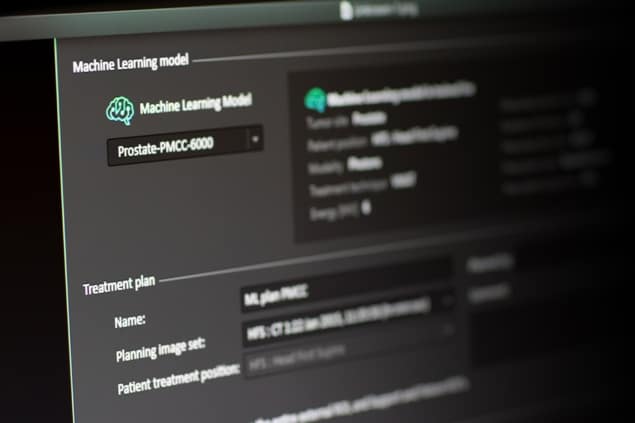
Machine learning and automation technologies are gearing up to transform the radiation-therapy workflow while freeing specialist clinical and technical staff to dedicate more time to patient care. That message will be front and centre for visitors to the booth of RaySearch Laboratories, the Stockholm-based oncology-software company, at the annual congress of the European Society for Radiotherapy and Oncology (ESTRO 38), which gets under way in Milan, Italy, on 26 April.
The ESTRO conference represents the official European unveiling of RayStation 8B, the latest release of RaySearch’s treatment-planning software. Among a raft of new features, perhaps the most anticipated are the machine-learning innovations that underpin RayStation’s capabilities in automated organ segmentation – in other words, quantitative 3D visualization – and automated treatment planning.
The goal is twofold: to deliver workflow efficiencies versus manual treatment planning, with plans delivered in minutes rather than hours; and to generate personalized treatment plans tailored to the unique needs of each patient. (See also “Machine learning: a game-changer for radiation oncology”.)
“Our machine-learning and deep-learning applications will help improve efficiency and consistency in the radiation-oncology clinic, reducing the dependence on an individual planner’s knowledge,” explains Emil Ekström, chief functionality owner for RayStation. What’s more, adds Ekström, “the machine-learning framework in RayStation 8B will facilitate knowledge-sharing, with radiation oncologists and medical physicists able to learn from each other through the machine-learning models.”

Machine learning: a game-changer for radiation therapy
Significantly, deployment of the machine-learning models is independent from the version of the treatment-planning software, with RaySearch adding models on a rolling basis so that customers will be able to access them without waiting for a new software release.
Clinics will also be able to train their own models for both segmentation and planning as well as share models with other facilities. “The nature of machine learning makes it possible to share models without the inclusion of personal data and thus creates unique opportunities for collaboration between cancer centres,” says Ekström.
User-centric innovation
Ekström, for his part, is at the sharp-end of RayStation product development, working alongside a 70-strong cross-functional team comprising computer scientists, UI/UX specialists, physicists, mathematicians and testers – all of them co-located at RaySearch’s Stockholm headquarters. Collectively their remit is to translate RayStation product strategy – which is owned and articulated at executive board level – into continuous improvement and product innovation for clinical customers.

“We put a lot of focus on the user experience, making RayStation look good and feel good to the user,” explains Ekström. “That means smooth workflows, not too many clicks, and access to the tools you need when you need them. The mindset is to make the software as intuitive and friction-free as possible, plus with every release we look to enhance the speed and efficiency of our algorithms.”
A case in point is RayStation’s new Monte Carlo dose engine, which delivers fast and accurate dose computation. RaySearch claims that the Monte Carlo dose for a dual-arc volumetric modulated-arc treatment (VMAT) plan can be computed in less than 60 seconds – “at least one order of magnitude faster than any other system on the market”.
“Users can expect improvements in the dose accuracy compared to the analytical dose engines in cases with large inhomogeneities, small fields and for dose out of field,” says Ekström. While the Monte Carlo dose engine for photons will ultimately be made available to all RayStation users, Ekström advises that it will be limited to selected clinical sites for the latest release.
Another prominent theme in RayStation 8B is robustness – specifically regarding the software’s “toolbox” for evaluating and comparing treatment plans and plan approval. The creation of robust treatment plans and the evaluation of robustness prior to delivery is one of the main challenges in radiation therapy.
“The quality of a radiation treatment plan depends strongly on the ability to deal with uncertainties that may originate from patient set-up, errors that may be associated with planning CT images, as well as from changes in patient anatomy over the course of treatment,” explains Ekström.
With this in mind, RayStation’s robust evaluation module provides a set of tools to compute and assess multiple error scenarios with different uncertainty settings. “That all translates into rapid decision support through the display of different robustness metrics versus the clinical goals of the treatment,” Ekström adds. (See also the webinar “Robustness in radiation therapy”.)
Next-generation therapies
Meanwhile, RaySearch continues to strengthen and diversify its support for a range of particle-therapy techniques and beamlines. Alongside new features for proton and carbon-ion planning, RayStation 8B’s planning capabilities have been extended in scope to cover boron neutron-capture therapy (BNCT). This emerging modality has shown significant promise in clinical trials to treat malignant brain tumours and recurrent head-and-neck tumours, both of which are difficult to combat with conventional radiotherapy techniques.
According to Ekström, the BNCT planning application – the result of a collaboration between RaySearch and the BNCT equipment makers Sumitomo Heavy Industries and Neutron Therapeutics – represents a significant milestone in the wider roll-out of BNCT technology.
“By adding support for BNCT planning in RayStation,” he explains, “we are creating the world’s first CE-marked and regulatory-approved treatment planning system for BNCT. This is crucial for the deployment of BNCT not only within clinical trials but also as an approved treatment from which more patients could benefit.”

Robustness in radiation therapy
In terms of market introduction, RaySearch will showcase RayStation 8B at the main spring and summer conferences in radiation oncology, starting with ESTRO 38 in Milan and followed by, among others, ICCR-MCMA 2019 (Montreal), PTCOG 58 (Manchester) and AAPM 2019 (San Antonio, Texas).
“Our strategy is to offer all customers, both existing and new ones, the latest version of RayStation,” Ekström concludes. “In some markets, though, it takes longer to get the necessary market approvals, so there is always a gradual roll-out of any new version.”
RaySearch Laboratories will be exhibiting on booth 1100 at the ESTRO 38 annual congress in Milan from 26-29 April.




